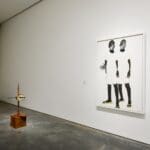Haunting Modernity
Gimpel Gallery, Paris, ca. 1900.COURTESY GIMPEL FILS
In Belonging and Betrayal: How Jews Made the Art World Modern, historian Charles Dellheim recounts the story of a commission that could have gone terribly awry. In 1900, Josse and Gaston Bernheim, the sons of respected Parisian art dealer Alexandre Bernheim, wanted to celebrate their engagement to two sisters, Mathilde and Suzanne Adler, by asking Pierre-Auguste Renoir to paint their fiancées’ portraits. The problem was that the Bernheims and their fiancées were Jewish, and Renoir’s willingness to accept a commission from Jewish patrons was in some doubt. The ongoing Dreyfus affair had split the Impressionists along political lines, with Claude Monet and Camille Pissarro sticking up for the falsely accused French officer, while Renoir, Edgar Degas, and their dealer, Paul Durand-Ruel, expressed their anti-Semitism publicly and privately. Hoping that Renoir’s interest in a lucrative commission would overcome his bias, the Bernheims sent him a proposal. He accepted, and the two women sat for Renoir over ten days at their home. The resulting portraits are charming, bearing no trace of the artist’s prejudice. Renoir remained friendly with both couples for years afterward.
Dellheim doesn’t tell this story to imply that spending time with the Bernheims and their fiancées made Renoir less disposed to anti-Semitism. Like dozens of similar anecdotes found in the pages of Belonging and Betrayal, the tale of the engagement portraits reveals the complex negotiations, spoken and unspoken, that structured social, economic, and political life for Jews in late nineteenth- and early twentieth-century western Europe.
































